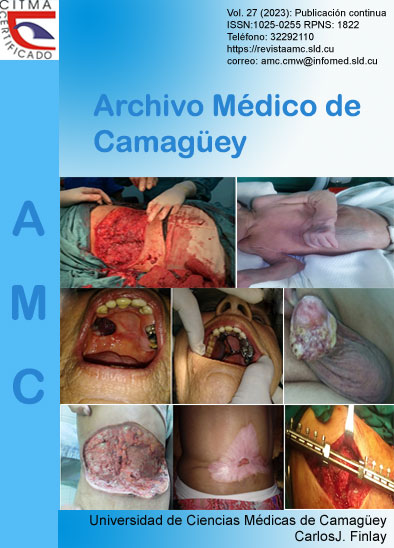Human health in the face of heat stress due to climate change
Abstract
Introduction: The alteration of the planetary climate, attributed directly or indirectly to human activity, which modifies the composition of the world atmosphere and adds to the natural variability of the climate, is known as global climate change. Its direct and indirect health effects, already present, will disturb most populations in the coming decades and put the lives and well-being of billions of people at risk.
Objective: To describe, based on a review, the main risks to human health derived from the greater frequency and intensity of episodes of thermal stress derived from climate change.
Methods: A bibliographic review was carried out regarding the effects of temperature on human health, as well as its influence on general mortality, in the period 2008 to 2021, in the Scopus, PubMed/Medline, SciELO, Ebsco, LiLACS, as well as other information sources and resources available on the Internet. The controlled vocabulary descriptors in Health Sciences were used.
Results: 32 publications on the influence of climate and its changes on human health were recovered, which generally stated that high temperatures were related to the increase in mortality, mainly due to cardiovascular, cerebrovascular and respiratory diseases, and have become a significant contributor to the burden of disease.
Conclusions: Extreme temperatures increase acute morbidity and mortality, mainly in risk groups. The promotion of adequate hydration and the use of adequate clothing will help people in the prevention of conditions caused by extreme temperatures, establishing individual actions to protect against the effects of the greater frequency and intensity of heat stress events associated with climate change, to incorporate into daily life.
DeCS:CLIMATE CHANGE; GLOBAL WARMING; HEAT STRESS DISORDERS; PEAK TEMPERATURE; HEALTH PROMOTION.
Downloads
References
1. Ahmed B. Call to Action. Health Care in the Face of the Climate Crisis. Circulation [Internet]. 2020 [citado 10 Nov 2021];141(13):1041-2. Disponible en: https://doi.org/10.1161/CIRCULATIONAHA.119.044922
2. Naciones Unidas [Internet]. Nueva York: ONU; 1992 [citado 29 Nov 2021]. Convención Marco de Naciones Unidas sobre Cambio Climático. Disponible en: https://unfccc.int/resource/docs/convkp/convsp.pdf
3. Favier Torres MA, Chi Ceballos M, Dehesa González LM, Veranes Dutil M. Efectos del cambio climático en la salud. Rev inf cient [Internet]. 2019 [citado 19 Nov 2021];98(2):272-82. Disponible en: http://scielo.sld.cu/scielo.php?script=sci_abstract&pid=S1028-99332019000200272
4. Costello A, Abbas M, Allen A, Ball S, Bell S, Bellamy R, et al. Managing the health effects of climate change: Lancet and University College London Institute for Global Health Commission. Lancet [Internet]. 2009 [citado 17 Nov 2021];373(9676):[aprox. 41 p.]. Disponible en: https://doi.org/10.1016/S0140-6736(09)60935-1
5. Oficina Internacional del Trabajo. Trabajar en un planeta más caliente: el impacto del estrés térmico en la productividad laboral y el trabajo decente [Internet]. Ginebra: OIT; 2019 [citado 29 Nov 2021]. Disponible en: https://www.ilo.org/wcmsp5/groups/public/---dgreports/---dcomm/---publ/documents/publication/wcms_768707.pdf
6. Instituto Nacional de Seguridad e Higiene en el Trabajo. NTP 922. Estrés térmico y sobrecarga térmica: evaluación de los riesgos (I) [Internet]. Madrid: INSHT; 2011 [citado 23 Nov 2022]. Disponible en: https://www.insst.es/documents/94886/328579/922w.pdf/86188d2e-7e81-44a5-a9bc-28eb33cb1c08
7. Instituto Nacional de Seguridad e Higiene en el Trabajo. NTP 1.036. Estrés por frío (I) [Internet]. Madrid: INSHT; 2015 [citado 23 Nov 2022]. Disponible en: https://www.insst.es/documents/94886/330477/NTP+1036.pdf/a13abd54-b298-4307-8298-a0289a2f24b2
8. Hall JE. Guyton y Hall. Tratado de Fisiología Médica. 13ª ed. Madrid: Elsevier; 2016.
9. Nunes AR. Misdiagnosing vulnerability to heatwaves in the media. Lancet Planetary Health [Internet]. 2019 [citado 17 Nov 2021];3(7): e293. Disponible en:
https://doi.org/10.1016/S2542-5196(19)30107-X
10. Ortiz Bultó PL, Pérez Rodríguez AE, Rivero Valencia A, Pérez Carreras A, Cangas JR, Lecha Estela LB. La variabilidad y el cambio climático en Cuba: potenciales impactos en la salud humana. Rev cuba salud pública [Internet]. 2008 Ene-Mar [citado 10 Dic 2021]; 34(1). Disponible en: http://scielo.sld.cu/scielo.php?script=sci_arttext&pid=S0864-34662008000100008
11. Fundación Española del Corazón [Internet]. Madrid: FEC; ©2022 [citado 17 Nov 2021]. Notas de prensa. Los cambios bruscos de clima, incrementan el riesgo cardiovascular. Disponible en: https://fundaciondelcorazon.com/prensa/notas-de-prensa/1133-cambio-bruscos-clima-incrementan-riesgo-patologias-cardiovasculares.html
12. Bhaskaran K, Armstrong B, Hajat S, Haines A, Wilkinson P, Smeeth L. Heat and risk of myocardial infarction: hourly level case-crossover analysis of MINAP database. BMJ [Internet]. 2012 Dic [citado 10 Nov 2021];345:e8050. Disponible en: https://pubmed.ncbi.nlm.nih.gov/23243290/
13. Vogt JJ. Calor y frío. En: Stellman JM, editor. Enciclopedia de salud y seguridad en el trabajo. VI. 4ta ed [Internet]. Madrid: OIT; 2012 [citado 25 Nov 2021]. p.42.1-42.61. Disponible en: https://www.insst.es/documents/94886/162520/Cap%C3%ADtulo+42.+Calor+y+fr%C3%ADo
14. Díaz Caravantes RE, Castro Luque AL, Aranda Gallegos P. Mortalidad por calor natural excesivo en el noroeste de México: Condicionantes sociales asociados a esta causa de muerte. Frontera Norte [Internet]. 2014 Jul-Dic [citado 19 Nov 2021];26(52):155-77. Disponible en: https://www.scielo.org.mx/pdf/fn/v26n52/v26n52a7.pdf
15. Revueltas Agüero M, Betancourt Bethencourt JA, del Toro Ramírez R, Martínez García Y. Caracterización del ambiente térmico laboral y su relación con la salud de los trabajadores expuestos. Rev cuban salud trabajo [Internet]. 2015 [citado 14 Nov 2021];16(2):3-9. Disponible en: https://www.medigraphic.com/pdfs/revcubsaltra/cst-2015/cst152a.pdf
16. Lecha Estela LB. El monitoreo y pronóstico de los efectos meteoro-trópicos, una vía efectiva para prevenir los impactos potenciales del cambio climático sobre la salud humana y la sociedad. 2015. DOI:10.13140/RG.2.1.3362.4801.
17. Watts N, Adger WN, Agnolucci P, Blackstock J, Byass P, Cai W, et al. Health and climate change: policy responses to protect public health. Lancet [Internet]. 2015 [citado 15 Nov 2021];386(10006):1861-1914. Disponible en:
https://pubmed.ncbi.nlm.nih.gov/26111439/
18. World Health Organization. Promoting Health While Mitigating Climate Change [Internet]. Geneva: WHO; 2015 [citado 28 Nov 2021]. Disponible en: https://cdn.who.int/media/docs/default-source/climate-change/discussion-paper---promoting-health-while-mitigating-climate-change.pdf?sfvrsn=de0dda16_2&download=true
19. Oudin Åström D, Schifano P, Asta F, Lallo A, Michelozzi P, Rocklöv J, et al. The effect of heat waves on Mortality in susceptible groups: a cohort study of a mediterranean and a northern European City. Environ Health [Internet]. 2015 [citado 30 Nov 2021];14:30. Disponible en: https://www.ncbi.nlm.nih.gov/pmc/articles/PMC4397690/
20. Gasparrini A, Guo Y, Hashizume M, Lavigne E, Zanobetti A, Schwartz J, et al. Mortality risk attributable to high and low ambient temperature: a multicountry observational study. Lancet [Internet]. 2015 Jul [citado 20 Nov 2021]; 386(9991): 369-75. Disponible en: https://pubmed.ncbi.nlm.nih.gov/26003380/
21. Gasparrini A, Guo Y, Hashizume M, Lavigne E, Tobias A, Zanobetti A, et al. Changes in Susceptibility to Heat During the Summer: A Multicountry Analysis. Am J Epidemiol [Internet]. 2016 [citado 30 Nov 2021];183:1027-36. Disponible en:
https://academic.oup.com/aje/article/183/11/1027/2739166
22. Ogbomo AS, Gronlund CJ, O’Neill MS, Konen T, Cameron L, Wahl R. Vulnerability to extreme-heat- associated hospitalization in three counties in Michigan, USA, 2000–2009. Int J Biometeorol [Internet]. 2017 May [citado 20 Nov 2021];61(5):833-43. Disponible en: https://www.ncbi.nlm.nih.gov/pmc/articles/PMC5410403/
23. Organización Panamericana de la Salud [Internet]. Washington: OPS; ©2018 [citado 07 Dic 2021]. Cambio climático y salud. Disponible en: https://www.paho.org/es/temas/cambio-climatico-salud
24. Bai L, Li Q, Wang J, Lavigne E, Gasparrini A, Copes R, et al. Increased coronary heart disease and stroke hospitalisations from ambient temperatures in Ontario. Heart [Internet]. 2018 Abr [citado 03 Dic 2021];104(8):673-79. Disponible en: https://www.ncbi.nlm.nih.gov/pmc/articles/PMC5890650/
25. Alonso Freire JL, Basanta Marrero LM, Santana Lugones JL, Alonso Basanta LD, Alonso Basanta CL. Experiencias y perspectivas futuras sobre la relación cambio climático y salud en Sagüa la Grande. Convención de salud [Internet]. Sagua la Grande: Hospital Mártires del 9 de Abril; 2018 [citado 07 Dic 2021]. Disponible en: http://www.convencionsalud2018.sld.cu/index.php/connvencionsalud/2018/paper/view/1166/666
26. Sanchez Martinez G, Diaz J, Hooyberghs H, Lauwaet D, De Ridder K, Linares C, et al. Cold-related mortality vs heat-related mortality in a changing climate: A case study in Vilnius (Lithuania). Environ Res [Internet]. 2018 Oct [citado 10 Dic 2021];166:384-93. Disponible en: https://pubmed.ncbi.nlm.nih.gov/29936286/
27. Rodríguez-Pacheco F, Jiménez-Villamizar MP, Pedraza-Álvarez LP. Efectos del cambio climático en la salud de la población colombiana. Duazary [Internet]. 2019 [citado 07 Dic 2021];16(2):319-31. Disponible en: https://doi.org/10.21676/2389783X.3186
28. Achebak H, Devolder D, Ballester J. Trends in temperature-related age-specific and sex-specific mortality from cardiovascular diseases in Spain: a national time-series analysis. Lancet Planet Health [Internet]. 2019 Jul [citado 10 Dic 2021];3(7):e297-e306. Disponible en: https://www.thelancet.com/journals/lanplh/article/PIIS2542-5196(19)30090-7/fulltext
29. Flouris AD, Ioannou LG, Dinas PC, Mantzios K, Gkiata P, Gkikas G, et al. Assessment of Occupational Heat Strain and Mitigation Strategies in Qatar. Report Number: FL/2019/13 [Internet]. Qatar: FAME Laboratory; 2019 [citado 30 Nov 2021 Nov 30]. Disponible en: https://www.ilo.org/wcmsp5/groups/public/---arabstates/---ro-beirut/documents/publication/wcms_723545.pdf
30. Alahmad B, Shakarchi A, Alseaidan M, Fox M. The effects of temperature on short-term mortality risk in Kuwait: a time-series analysis. Environ Res [Internet]. 2019 Abr [citado 29 Nov 2021];171:278-84. Disponible en: https://pubmed.ncbi.nlm.nih.gov/30703623/
31. Epstein Y, Yanovich R. Heatstroke. N Engl J Med. 2019;380:2449-59. doi: 10.1056/NEJMra1810762.
32. Arias Ávila AJ, Bonilla García KJ, Castaño Marín LM, Jiménez Castro V, Sánchez Correa LF. Relación entre la incidencia de síndrome coronario agudo y las islas de calor urbano en la ciudad de Bogotá D.C entre el año 2014 y el 2019 [Internet]. Bogotá D.C: Universidad de Ciencias Aplicadas y Ambientales UDCA; 2019 [citado 21 Nov 2021]. Disponible en: https://repository.udca.edu.co/bitstream/handle/11158/2689/ICU%20ENTREGA%20FINAL%20%281%29.pdf?sequence=1&isAllowed=y
33. Christidis N, Mitchell DM, Stott PA. Anthropogenic climate change and heat effects on health. Int J Climatol [Internet]. 2019 [citado 20 Nov 2021];39:4751- 68. Disponible en: https://rmets.onlinelibrary.wiley.com/doi/epdf/10.1002/joc.6104
34. Cheng J, Xu Z, Bambrick H, Su H, Tong S, Hu W. Impacts of exposure to ambient temperature on burden of disease: A systematic review of epidemiological evidence. Int J Biometeorol. 2019 Ago;63(8):1099-115. doi: 10.1007/s00484-019-01716-y.
35. García-Lledó A, Rodríguez-Martín S, Tobías A, Alonso-Martín J, Ansede-Cascudo JC, de Abajo FJ. Olas de calor, temperatura ambiente y riesgo de infarto de miocardio: un estudio ecológico en la Comunidad de Madrid. Rev Esp Cardiol [Internet]. 2020 Abr [citado 21 Nov 2021];73(4):300-6. Disponible en: https://www.revespcardiol.org/es-olas-calor-temperatura-ambiente-riesgo-articulo-S0300893219302131
36. Alahmad B, Khraishah H, Shakarchi AF, Albaghdadi M, Rajagopalan S, Koutrakis P, et al. Cardiovascular Mortality and Exposure to Heat in an Inherently Hot Region Implications for Climate Change. Circulation [Internet]. 2020 Abr [citado 21 Oct 2021];141(15):1271-3. Disponible en: https://www.ncbi.nlm.nih.gov/pmc/articles/PMC9060422/
37. Alahmada B, Shakarchic AF, Khraishahd H, Alseaidanf M, Gasanab J, Al-Hemoudg A, et al. Extreme temperatures and mortality in Kuwait: Who is vulnerable?. Sci Total Environ [Internet]. 2020 Ago [citado 29 Nov 2021];732:139289. Disponible en: https://pubmed.ncbi.nlm.nih.gov/32438154/
38. Dimitrova A, Ingole V, Basagaña X, Ranzani O, Mil? C, Ballester J, et al. Association between ambient temperature and heat waves with mortality in South Asia: Systematic review and meta-analysis. Environ Int [Internet]. 2021 Ene [citado 29 Nov 2021];146:106170. Disponible en: https://pubmed.ncbi.nlm.nih.gov/33395923/
39. Masson-Delmotte V, Zhai P, Pirani A, Connors SL, Péan C, Berger S, et al. (eds.) IPCC, 2021: Summary for Policymakers. In: Climate Change 2021: The Physical Science Basis. Contribution of Working Group I to the Sixth Assessment Report of the Intergovernmental Panel on Climate Change [Internet]. Cambridge: Cambridge University Press; 2021 [citado 21 Oct 2021]. Disponible en: https://pure.iiasa.ac.at/id/eprint/17364/1/IPCC_AR6_WGI_Full_Report.pdf
40. Zhao Q, Guo Y, Ye T, Gasparrini A, Tong S, Overcenco A, et al. Global, regional, and national burden of mortality associated with non-optimal ambient temperatures from 2000 to 2019: a three-stage modelling study. The Lancet Planetary Health. 2021;5(7):e415-e425. DOI: 10.1016/S2542-5196(21)00081-4.
41. Hanigan IC, Dear KBC, Woodward A. Increased ratio of summer to winter deaths due to climate warming in Australia, 1968–2018. Aust N Z J Public Health [Internet]. 2021 Oct [citado 21 Oct 2021];45(5):504-5. Disponible en: https://pubmed.ncbi.nlm.nih.gov/33900671/
Published
How to Cite
Issue
Section
License
Copyright: Camagüey Medical Archive Magazine, offers immediately after being indexed in the SciELO Project; Open access to the full text of the articles under the principle of making available and free the research to promote the exchange of global knowledge and contribute to a greater extension, publication, evaluation and extensive use of the articles that can be used without purpose As long as reference is made to the primary source.
Conflicts of interest: authors must declare in a mandatory manner the presence or not of conflicts of interest in relation to the investigation presented.
(Download Statement of potential conflicts of interest)
The Revista Archivo Médico de Camagüey is under a License Creative Commons Attribution-Noncommercial-No Derivative Works 4.0 International (CC BY 4.0).
This license allows others to distribute, to mix, to adjust and to build from its work, even for commercial purposes, as long as it is recognized the authorship of the original creation. This is the most helpful license offered. Recommended for maximum dissemination and use of licensed materials. The full license can be found at: https://creativecommons.org/licenses/













 22 julio 2025
22 julio 2025